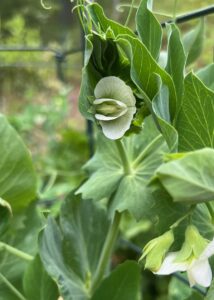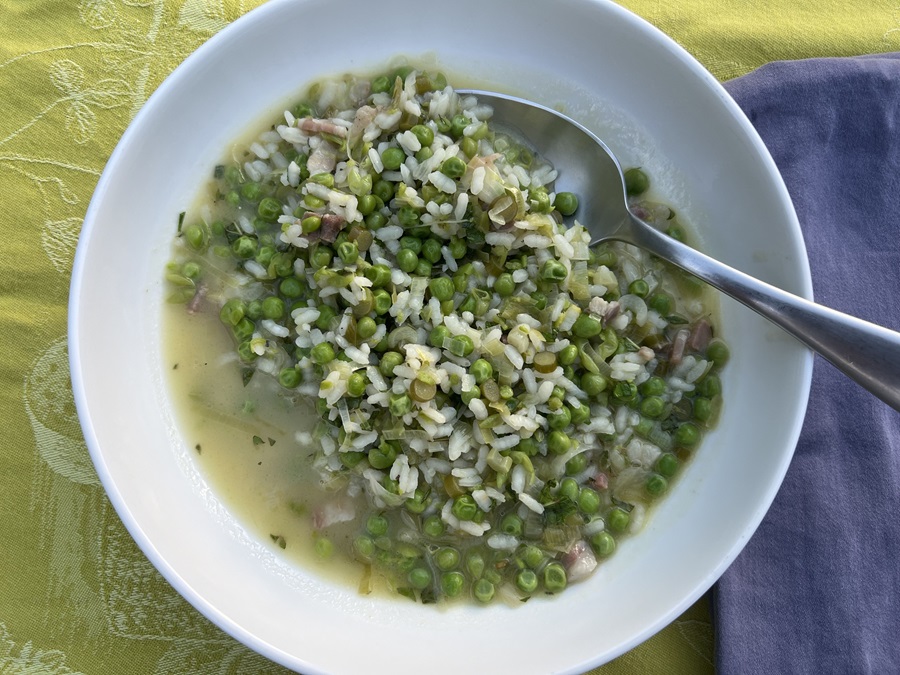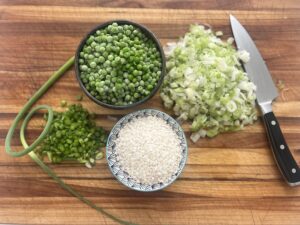Every year I tempt fate and plant my peas dangerously early. It’s worth the risk so that I can look out on gray, chilly spring days and see green poking up in the kitchen garden. Even when we’re a long way from summer, peas offer the promise of it. In the mornings I bundle up, coffee in hand, to check on their progress: first the little shoots, then the fragile grasping tendrils reaching for the wire frame. When their white flowers appear, I know that peas will soon be on the menu.
Fresh peas are a fleeting wonder and one of my favorite things to eat, sometimes raw right in the garden. Or, if we’re grilling, I might throw them on. I learned from the kitchen at Tres Gatos, one of our neighborhood favorites when we lived in Jamaica Plain, to slick English peas in their tough carapaces with olive oil and toss them right onto a hot grill. You eat the sweet and smoky peas with your fingers right from their charred shells, sprinkled with grated Parmesan.

Once there’s a real crop in, I like to make risi e bisi, a specialty of the Veneto region — rice and peas in the Venetian dialect. It has none of the creamy unctuousness of risotto; instead, it is light, brothy, and fresh. Traditionally made with a peapod stock and flavored with pancetta, risi e bisi is served with a spoon in Italy, and that’s how I first ate it during a trip to Venice. I was 22 years old and on break from studying in Paris. Stepping off the exhaust-belching vaporetto onto that fabled island felt like jumping through the looking glass. Because I’m of a certain age, this was a time before big cruise ships disgorged in Venice, when the twisty lanes weren’t yet clogged with TikTok-ing tourists. The Piazza San Marco had yet to be submerged in annual floods back then, and there were only short waits to see the Tintorettos at the Madonna dell’Orto.
My friends and I stayed in a huge, rundown pensione suggested by our Let’s Go guide, all of us in one gigantic, high-ceilinged room that must have been elegant in its time. Now the paint was peeling and the room outfitted with four utilitarian double beds and random pieces of scarred and mismatched furniture. A stone balcony overlooked a small piazza, and in the piazza was a restaurant to which the grumpy hotel portiere sent us for our supper.

The restaurant was minuscule and spilled out into the street. The spring evening was chilly, but we sat outside all buttoned up so as not to miss a thing. The waiter suggested sardines in saor, which is kind of like an escabeche, and risi e bisi, so that’s what we ordered, along with a bottle of the least expensive Soave on the menu.
The sardines were too exotic for us: we weren’t sure what to do with all those bones. But then the steaming risi e bisi arrived in a clattering of shallow bowls and silver spoons: the bright peas were sweet against the soft, green-tinted rice; the broth was deeply vegetal, with salty notes from the pancetta and Parmesan. It somehow emboldened us to use an amalgam of Romance languages to chat with diners at nearby tables. In my memory of it all, the waiter even warmed to us.
As with most traditional dishes, there are many variations of risi e bisi. Some recipes call for garlic, others omit it. Some versions go for a texture more like risotto, while others are more soup-like. There are those who use chicken stock, but when the fresh peas are in, pea broth is the thing to try. I’ll give a recipe here.
If you’re making the dish right away, before our fresh peas have appeared, you might make a broth out of those Parmesan rinds you’ve been saving — if you can find the little bag of them in the bottom of your refrigerator. For that, simmer about 12 ounces of cheese rinds, a coarsely chopped onion, a whole head of garlic sliced in half, several parsley and thyme sprigs, a teaspoon of peppercorns and another of salt, and two bay leaves for 45 minutes.

The rice people in the Veneto use for risi e bisi is called Vialone Nano, which cooks quickly, but the more commonly available Arborio will also work. The technique for this dish is different from that of risotto in that the broth is incorporated in just one or two additions — no need to stir it in little by little.
As for the peas, the season is short, and we mustn’t be purists: frozen peas are one of modern life’s wonders. If you’re using them, add the peas later because they take no time at all to cook. You’ll also want to puree some of the peas to deepen the flavor of the dish.
The lemon zest and mint are garnish ideas borrowed from some of Gabrielle Hamilton’s recipes.
Neither the Venice of my memory nor the person I was when I visited exists any longer. I probably won’t see the city again. But when I read about its struggles, both environmental and touristic, I think perhaps that’s for the best. Maybe I can be content with a bowl of risi e bisi and a spoon right here in Truro.
VENETIAN-STYLE RISI E BISI
Makes 4 servings
For the peapod broth:
Pods from 2 lbs. peas, rinsed and coarsely chopped
1 medium onion, peeled and sliced
2 medium carrots, scrubbed and sliced
2 or 3 Parmesan rinds
Salt
For the risi e bisi:
4 Tbsp. extra-virgin olive oil, plus more for drizzling
3 Tbsp. unsalted butter, divided
3 oz. pancetta, finely chopped
2 medium leeks, white and light green parts sliced thin (or 1 onion)
3 garlic scapes or 2 garlic cloves, chopped fine
2 cups shelled fresh peas (or frozen peas, not the tiny petit pois)
5 cups peapod broth, homemade Parmesan broth, or chicken stock
1 cup short-grain rice like Vialone Nano or Arborio
Kosher salt to taste
½ cup dry white wine
2 oz. grated Parmesan (about 1 cup), plus more for serving
3 Tbsp. minced mint
1 tsp. grated lemon zest
Freshly ground black pepper
- Make the broth. Add peapods, onion, carrots, cheese rinds, 1 tsp. salt, and 2 quarts of water to a large pot. Bring to a boil and reduce the heat to a slow simmer for about a half hour. Remove from heat and allow the broth to cool, then strain out the solids and return the stock to a saucepan and keep warm.
- In a wide saucepan, heat the oil and 1 Tbsp. of the butter. Add the pancetta and cook over medium heat, stirring occasionally, about 3 minutes. Add leeks or onion and cook, stirring often, until softened and golden, 5 to 8 minutes. Add garlic scapes or garlic and cook, stirring, until softened, about 1 more minute.
- If using fresh peas, add them now along with a ladle of broth. Cover and gently simmer until the peas are just almost tender. (If using frozen peas, move to the next step and add all the broth at once.)
- Stir in rice. Season with salt and stir, then add the wine. Allow to cook for a minute or two, then add the rest of the broth. Allow to simmer softly, uncovered, stirring from time to time until the rice is tender, about 15 to 20 minutes. The dish should be soupy, so if it dries out, add additional broth or water. The goal is for the rice to be just soft without becoming mushy.
- If using frozen peas, defrost and mash or puree a half cup of them to up the pea flavor. Stir in the peas and puree when the rice is just cooked.
- Remove the pan from the heat and stir in Parmesan cheese, remaining butter, mint, and lemon zest. Taste and correct salt and add freshly cracked pepper. Divide risi e bisi among shallow bowls and top with more shaved Parmesan and a drizzle of olive oil.



